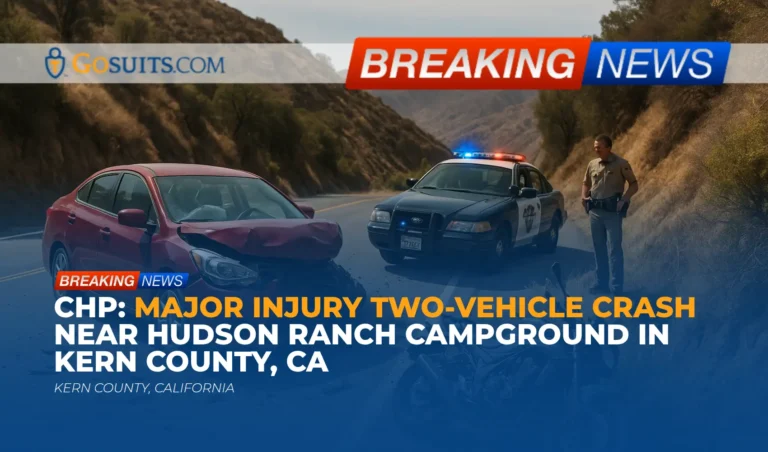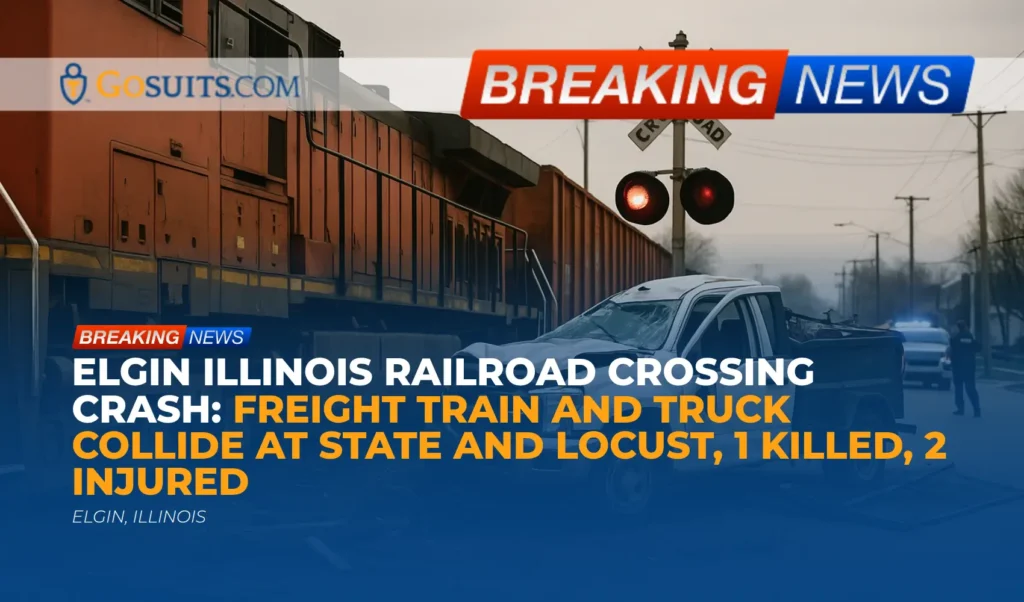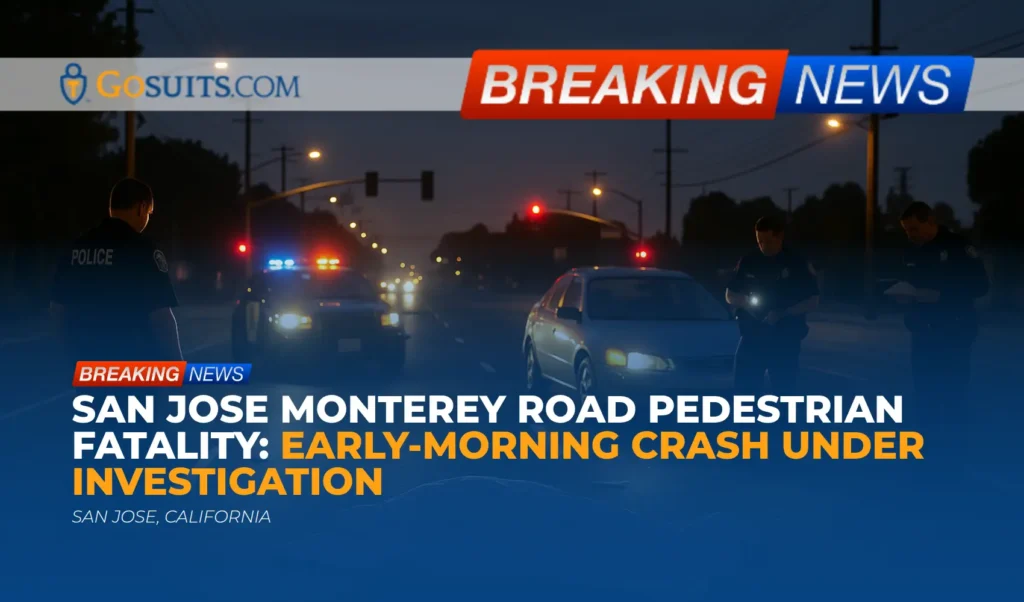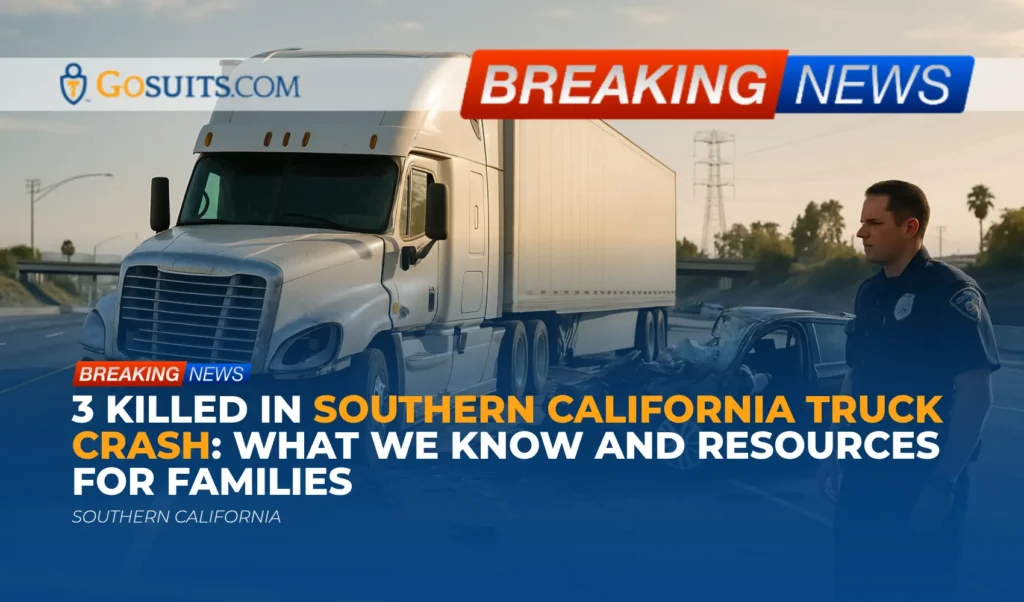- What We Know About the Collision Near Hudson Ranch Campground
- Location and Conditions
- Who Was Involved and Reported Injuries
- Why an Initial Non-Injury Report Can Become a Major Injury Collision
- Immediate Steps for Those Affected
- How to Obtain Official Records and Information
- Potential Legal Considerations in Two-Vehicle and Motorcycle Crashes
- Insurance Issues and Protecting Your Rights
- If a Loved One Was Lost
- Safety Notes for Mountain and Canyon Roads
- Deadlines That May Apply in California Cases
- Community Resources and Agencies
- Call-to-Action: Practical Steps to Take Now
- Commentary from Gosuits Bakersfield, California Personal Injury Attorney
What We Know About the Collision Near Hudson Ranch Campground
According to reports, a major traffic collision occurred near the Hudson Ranch Campground on Sunday, October 19, just before 2 p.m. The California Highway Patrol indicated the crash involved two vehicles and led to significant injuries. The incident was initially classified as a non-injury collision, then later updated by the California Highway Patrol to a major injury collision as additional facts emerged. One of the vehicles involved, a bike, was reportedly found caught in bushes and hanging over the side of the road approximately 50 feet from the top of the mountain. The investigation is ongoing.
It is not uncommon for the early moments of a response to be fluid, with first responders refining the understanding of injuries and vehicle positions as they gain access to the scene and locate everyone involved. The update from non-injury to major injury underscores how evolving information during rescue and assessment can significantly change the classification.
Location and Conditions
The crash was reported near Hudson Ranch Campground with references to a mountain roadway and a steep drop-off. Mountain and canyon roads in the Bakersfield area can include narrow lanes, tight curves, changing elevations, rockfall zones, and limited shoulder space. These conditions can complicate both the cause and the response to a crash, especially when a motorcycle or bicycle leaves the roadway and comes to rest down a slope or in thick brush.
Visibility, road surface condition, and traffic flow in these areas can change quickly. Even on clear days, shaded curves may conceal debris or moisture on the pavement, and drivers descending or ascending grades must manage speed and braking with extra care. While the specific weather and road conditions for this incident are not provided, these general features of mountain routes are relevant to understanding how severe injuries can occur in a two-vehicle crash that involves a rider going off the roadway.
Who Was Involved and Reported Injuries
Authorities indicated two vehicles were involved and that significant injuries were sustained. One of the vehicles was a bike found over the side of the roadway. The report does not include names, ages, or the number of occupants in each vehicle, nor does it attribute fault. Because the investigation is ongoing, details about exactly how the collision occurred and the full extent of injuries may be released later through official channels such as a California Highway Patrol collision report.
When a rider or vehicle goes down an embankment, injuries can range widely. The classification of “major injury” suggests that responders observed signs of serious harm, which could include suspected broken bones, significant bleeding, or loss of consciousness. These determinations are formalized in the collision report and medical records, and they materially affect any subsequent insurance claim and civil case evaluation.
Why an Initial Non-Injury Report Can Become a Major Injury Collision
In the first minutes after a crash, dispatch entries are often based on what callers can see or what can be observed without access to all occupants. If a rider is down a slope or not immediately visible, responders may initially classify the event differently until they reach and assess that person. Injury severity is also defined by specific criteria used by law enforcement and medical professionals.
National guidance that many jurisdictions reference describes a suspected serious injury as one with visible evidence of significant damage, such as severe lacerations, fractured limbs, crush injuries, or unconsciousness. For background on how serious injuries are generally categorized in crash reporting, see federal guidelines on uniform crash criteria from the National Highway Traffic Safety Administration. While terms may vary by state, suspected serious injuries are distinguished from minor or non-visible complaints. Reference: NHTSA crash data guidelines.
California’s traffic injury data also commonly uses standardized severity categories. Academic transportation safety resources describe the typical scale used in state crash databases, including fatal, severe injury, other visible injury, and complaint of pain. Reference: UC Berkeley TIMS injury severity definitions. In practice, when responders find a rider down a steep hillside or with clear signs of trauma, a reclassification to major or severe injury is expected.
Immediate Steps for Those Affected
The period after a serious crash is disorienting. The following actions are general, practical steps that can help protect health, document what happened, and preserve rights. If someone is in immediate danger, call 9-1-1.
- Get medical care first. Even if symptoms seem mild at first, evaluation is crucial. Internal injuries, head trauma, and spinal injuries may not be obvious. Follow-up care and documentation matter for both health and any future claim.
- Preserve evidence. Keep photos and videos of the scene, vehicle positions, skid marks, debris fields, guardrails, and any visible injuries. If the bike or vehicle went down an embankment, note the approximate location and any landmarks.
- Identify witnesses. Collect names and contact information for anyone who saw the collision, roadside assistance responders, and nearby campers or hikers who might have relevant observations.
- Secure the vehicles and gear. Store helmets, riding gear, and damaged parts. Do not discard items even if they seem broken or unusable. Physical damage patterns can help accident reconstruction.
- Obtain the incident number. Ask the California Highway Patrol or responding agency for the report or incident number to request the official collision report later.
- Be cautious with insurance communications. Consider speaking with a qualified attorney before giving any recorded statement or signing documents. What is said to an insurer can be used later to challenge a claim.
How to Obtain Official Records and Information
California Highway Patrol collision report
CHP prepares a traffic collision report that contains diagrams, statements, officer observations, and the initial assessment of factors. Eligible parties can request a copy by submitting the CHP request form and required identification.
- Where to request: California Highway Patrol Collision Report Request.
- Form and instructions: How to obtain a traffic collision report (CHP).
- Who may obtain: Typically drivers, passengers, property owners, parents or guardians of minors, and legal representatives.
- Timing: Reports may take days or weeks depending on the complexity of the investigation, especially for incidents requiring scene measurements or specialized follow-up.
Medical records
Hospitals and clinics keep records of diagnoses, imaging, procedures, and discharge notes. Requesting copies often requires a signed authorization. These records are essential for documenting injury severity and treatment.
Coroner and autopsy records if a fatality occurred
If a collision results in a death, the county coroner’s office oversees the medico-legal investigation and may produce an autopsy report. Families can contact the county sheriff-coroner to ask about the process and timeline. In California, certified death certificates can be requested through the California Department of Public Health. Reference: California Department of Public Health Vital Records.
Death certificate copies
CDPH provides guidance on obtaining certified copies of death certificates, which may be necessary for life insurance claims, probate, or certain civil claims. Reference: CDPH certified copies information.

Roadway hazards and maintenance records
If roadway conditions may have contributed, maintenance logs and service requests can be relevant. To report or inquire about state highway maintenance issues or hazards, see Caltrans. Reference: Caltrans maintenance service request.
Potential Legal Considerations in Two-Vehicle and Motorcycle Crashes
Every crash is unique, yet certain recurring questions arise in mountain roadway collisions and two-vehicle incidents involving a rider. The following are general considerations that may be evaluated by insurers and, later, by a court if a civil claim is filed.
- Right of way and lane position. How vehicles entered and traveled through curves, whether a vehicle crossed the center line, and whether one party made a sudden turn or unsafe pass.
- Speed management. Whether either party was traveling at an unsafe speed for the curve, grade, or visibility, even if within the posted limit.
- Following distance. On winding roads, tailgating reduces the margin needed to react to unexpected debris, animals, or a vehicle slowing for a sharp bend.
- Roadway condition. Gravel, potholes, oil, or uneven pavement can be critical for riders. If a public agency had prior notice of a dangerous condition and failed to address it in time, additional legal questions can arise under California’s Government Claims Act.
- Vehicle condition. Brake function, tire condition, and lighting. A mechanical failure does not automatically excuse a driver from responsibility, but it may affect fault analysis.
- Visibility and sightlines. Vegetation, terrain, and guardrails can affect whether a driver could reasonably see and avoid a hazard in time.
- Helmet and protective gear. In rider cases, gear can reduce injury severity, but gear usage does not bar a claim against a negligent party. Insurers may attempt to argue reduced damages based on gear or speed; each case requires careful evidence review.
California civil law also recognizes comparative fault, which means responsibility for damages can be apportioned among parties based on their respective contributions to the crash. Even if an injured person is assigned some percentage of fault, recovery may still be possible for the portion attributable to another party. How this applies depends entirely on the facts documented in the collision report, scene evidence, and witness accounts.
Insurance Issues and Protecting Your Rights
Insurance companies analyze collisions using the official report, photographs, recorded statements, medical records, and vehicle inspections. The way information is presented early can have a long-term impact on a claim’s outcome. Consider these points:
- Speak carefully and sparingly. Consider consulting an attorney before providing a recorded statement to any insurer, including your own. Statements can be used to minimize or dispute injuries and liability.
- Do not rush to settle. Early offers often arrive before the full extent of injuries is known. Accepting funds may close the claim and bar later recovery for additional treatment.
- Document functional losses. Keep a simple journal of pain levels, missed work, limited activities, and daily challenges. This record helps explain the real-world effects of injuries.
- Mind medical billing details. Track explanation of benefits, provider bills, and liens. Coordination between health insurance and auto insurance can be complex.
- Uninsured and underinsured motorist coverage. If the at-fault driver has no or low coverage, your own policy’s UM/UIM protections may be critical. Policies differ in notice requirements and arbitration provisions.
For collisions possibly linked to a dangerous roadway condition on a state-maintained route, a separate claim process may apply. California’s Government Claims Act generally requires that claims for money damages against a state agency be presented within six months of the incident. References: Gov. Code section 911.2 and California DGS, How to File a Claim. These rules are strict and separate from the ordinary civil filing deadline, and they can apply even when a private driver is also involved.
If a Loved One Was Lost
The news report references significant injuries but does not confirm any fatalities. If a death were to be involved, families face immediate emotional and practical burdens. In addition to medical and coroner contacts, California has time limits and documentation steps that are important to understand.
- Coroner processes. The county coroner typically determines cause of death and may conduct an autopsy. Families can request guidance on when reports will be available and how to request copies.
- Death certificates. Certified copies are needed for many administrative tasks. Reference: CDPH certified copies.
- Personal property. Ask the investigating agency about retrieval of personal effects and vehicle release procedures.
- Civil claims timeline. California generally allows two years from the date of death for certain civil actions. Reference: Code of Civil Procedure section 335.1. Claims involving public entities require additional early steps per the Government Claims Act above.
- Support for grief and trauma. Crashes can cause acute stress and long-term grief. The 988 Suicide and Crisis Lifeline is available and can connect callers with support. Reference: SAMHSA 988 Lifeline.
Safety Notes for Mountain and Canyon Roads
Because this collision occurred by a mountain route with a steep drop, it is worth discussing general safety considerations for riders and drivers in similar environments. These are not judgments about this event, but practical reminders drawn from public safety research.
- Cornering and speed control. Riders and drivers should reduce speed before entering curves, maintain a steady line through the turn, and accelerate gradually upon exit. Sudden braking mid-curve increases the risk of losing traction.
- Surface hazards. Gravel, sand, and broken pavement are common on mountain roads. Riders should scan for patches and adjust lane position to avoid them safely.
- Protective gear. DOT-compliant helmets, jackets with armor, gloves, and boots reduce injury severity. NHTSA notes that proper helmet use substantially reduces the risk of head injury and death. Reference: NHTSA motorcycle safety.
- Visibility strategies. High-visibility gear, daytime running lights, and lane positioning that maximizes sightlines can help others see riders sooner.
- Training and refreshers. California’s Motorcycle Training Course offers instruction for new and experienced riders. Reference: California DMV Motorcyclist Training Course.
Data-driven insights underscore the stakes. National sources show that single-vehicle motorcycle crashes frequently involve roadway departures and curves, and that helmet use substantially reduces fatal and serious head injuries. Reference: NHTSA motorcycle safety.
Deadlines That May Apply in California Cases
Time limits vary by claim type and who is allegedly responsible. Missing a deadline can end a claim before it begins, so tracking these dates is vital.
- General personal injury and wrongful death. In many cases, California sets a two-year period from the date of injury or death. Reference: Code of Civil Procedure section 335.1.
- Claims involving public entities. If alleging a dangerous condition of public property or the actions of a public employee, a written claim often must be presented to the appropriate government office within six months. Reference: Government Code section 911.2. State-level claims are generally handled through the Department of General Services. Reference: DGS claim filing.
- Insurance notice requirements. Auto insurance policies may require prompt notice of a collision and cooperation with reasonable requests. Consider timing requirements, but approach communications carefully to avoid statements that could be misinterpreted.
Because multiple deadlines can apply at once, coordinated planning is important. Early evidence preservation can make later steps smoother, whether the matter resolves through insurance or proceeds to court.
Community Resources and Agencies
Here are agencies and offices often involved after a serious collision near Bakersfield. Contact details can be found on each agency’s public website or by calling directory assistance.
- California Highway Patrol, Bakersfield Area. For the incident number, collision report requests, and to provide supplemental information to the investigating officer. Reference for report requests: CHP collision report request.
- Kern County Sheriff-Coroner. For information on coroner procedures, property release, and autopsy requests if a death occurred. County websites provide guidance on how families can request records.
- Local hospitals and trauma centers. Medical records departments can assist with requests for emergency department notes, imaging, and discharge summaries.
- California Department of Public Health, Vital Records. For certified copies of death certificates and general vital records. Reference: CDPH Vital Records.
- Caltrans. To report a roadway hazard on state-maintained routes and to inquire about maintenance timelines. Reference: Caltrans service request.
- SAMHSA 988 Lifeline. For immediate emotional support related to trauma or grief. Reference: 988 information.
Call-to-Action: Practical Steps to Take Now
- Document and preserve. Secure photos, videos, dashcam files, and the damaged bike or vehicle. Keep all medical paperwork, discharge instructions, and receipts together in a single folder. Acting now prevents loss of evidence due to repairs, weather, or time.
- Request official reports. Make a plan to obtain the CHP collision report once available and to follow up for any supplemental reports. The report will anchor insurance evaluations and can correct misunderstandings if statements in the field were incomplete.
- Map deadlines. Write down the collision date and mark key civil and administrative deadlines on a calendar, including the two-year civil period and any six-month government claim window that could apply if a public entity is involved. Early tracking avoids last-minute emergencies.
- Be cautious with insurers. Before giving any recorded statement or accepting an offer, consult with a seasoned attorney through a free consultation to understand rights and obligations. Early statements can narrow options later, and settlement documents can permanently close claims.
- Follow through on medical care. Attend follow-up visits and recommended therapies. Consistent care protects health and creates a clear medical timeline, which matters in any claim analysis.
- Note the human impact. Keep a simple daily log of pain, sleep disruptions, missed activities, and work limitations. Specific, dated notes help explain the invisible parts of an injury that photos cannot capture.

Commentary from Gosuits Bakersfield, California Personal Injury Attorney
Our hearts go out to everyone affected by the collision near Hudson Ranch Campground. Mountain roadway crashes are frightening for everyone involved, and the report of a bike down a steep hillside is especially concerning. This commentary is provided for educational and general information purposes, with respect for those who are recovering and those who assisted at the scene.
From a civil injury perspective, the shift from a non-injury classification to a major injury collision is an important reminder that early dispatch notes rarely tell the whole story. On routes with steep drop-offs, responders may need additional time to find and safely reach all parties. Once a rider is located and evaluated, the severity picture can change quickly. When reports become available, they often clarify key facts like lane position, speed estimation, sightlines, and whether debris or road condition played a role.
In incidents involving a rider and another vehicle, several questions usually guide the analysis. Did one vehicle cross the center line in a curve, or brake abruptly without a safe following distance behind? Were there visual obstructions or surface hazards that limited reaction time? Did the roadway design or maintenance contribute to a loss of control? The answers to these questions often come from careful review of the CHP report, photographs, witness statements, and, in some cases, an inspection of the scene. We also look at whether any government claim requirements might be triggered if a dangerous condition of public property is credibly involved.
Insurance companies and large corporations know that people caught in the aftermath of a serious crash are overwhelmed, in pain, and unsure what to say. Adjusters may request a recorded statement soon after the collision, ask broad questions about prior health conditions, or offer quick settlements before injuries are fully understood. These strategies can limit the scope of a claim or reduce the value assigned to medical care and long-term effects. Once a statement is recorded, it is difficult to unwind, and once a release is signed, the claim is typically closed for good. Taking the time to understand rights, evidence needs, and timelines before engaging deeply with an insurer is a practical way to avoid common pitfalls.
A free consultation can provide clarity at a stressful time. It helps people understand how the facts, medical treatment plan, and insurance coverages interact, and what steps will best protect their interests while they focus on healing. Whether a matter resolves through negotiation or proceeds further, informed decisions made early often determine whether important evidence is preserved and key deadlines are met.
References
- California Highway Patrol Collision Report Request
- CHP guidance on obtaining a traffic collision report
- UC Berkeley TIMS, injury severity definitions used in California crash data
- NHTSA, Uniform Guidelines for Crash Data
- NHTSA, Motorcycle Safety
- California DMV, Motorcyclist Training Course
- CDPH, Obtaining Certified Copies of Vital Records
- Caltrans, Submit a Maintenance Service Request
- California Code of Civil Procedure section 335.1
- California Government Code section 911.2
- California Department of General Services, How to File a Claim
- SAMHSA, 988 Suicide and Crisis Lifeline






